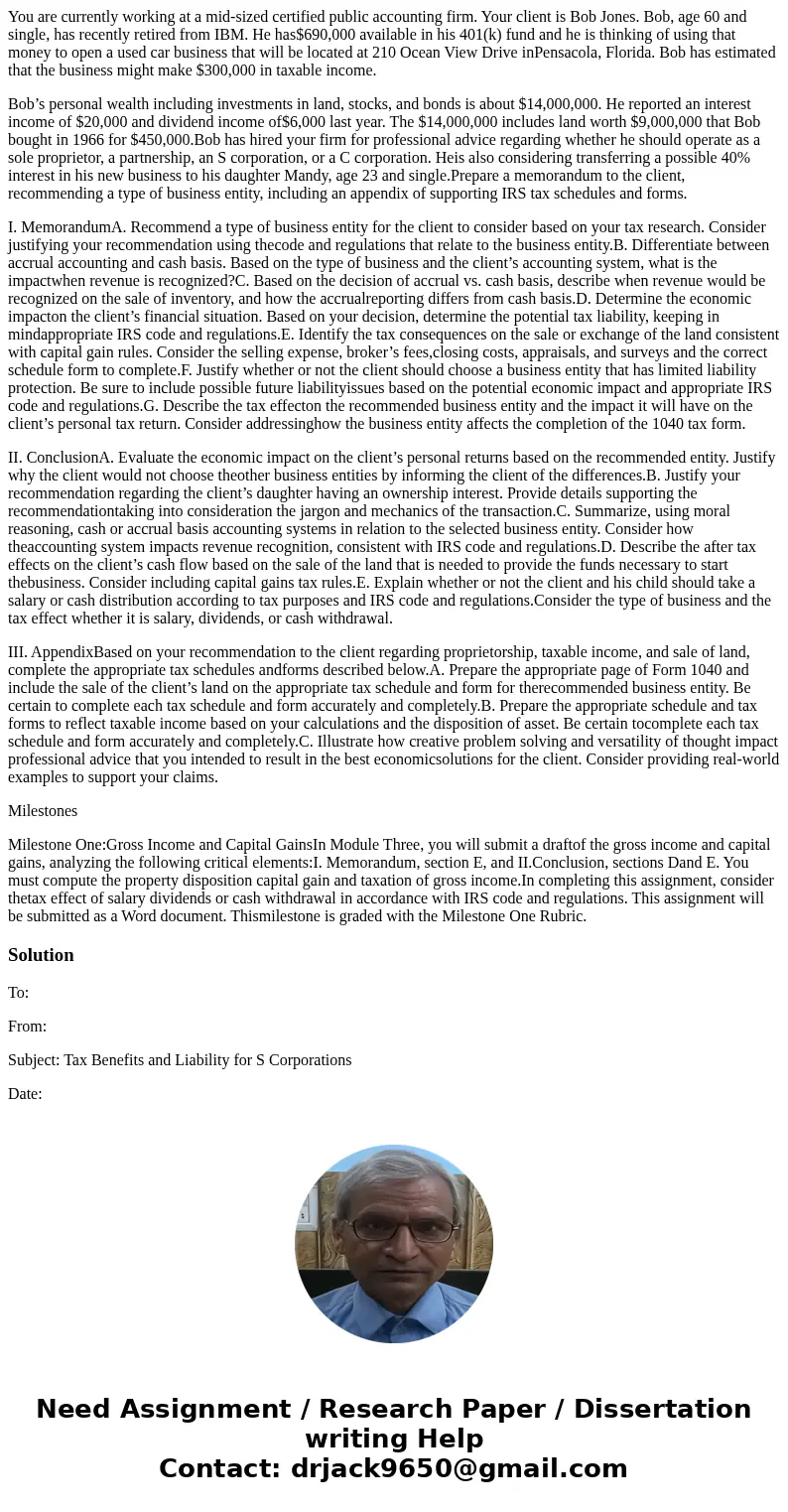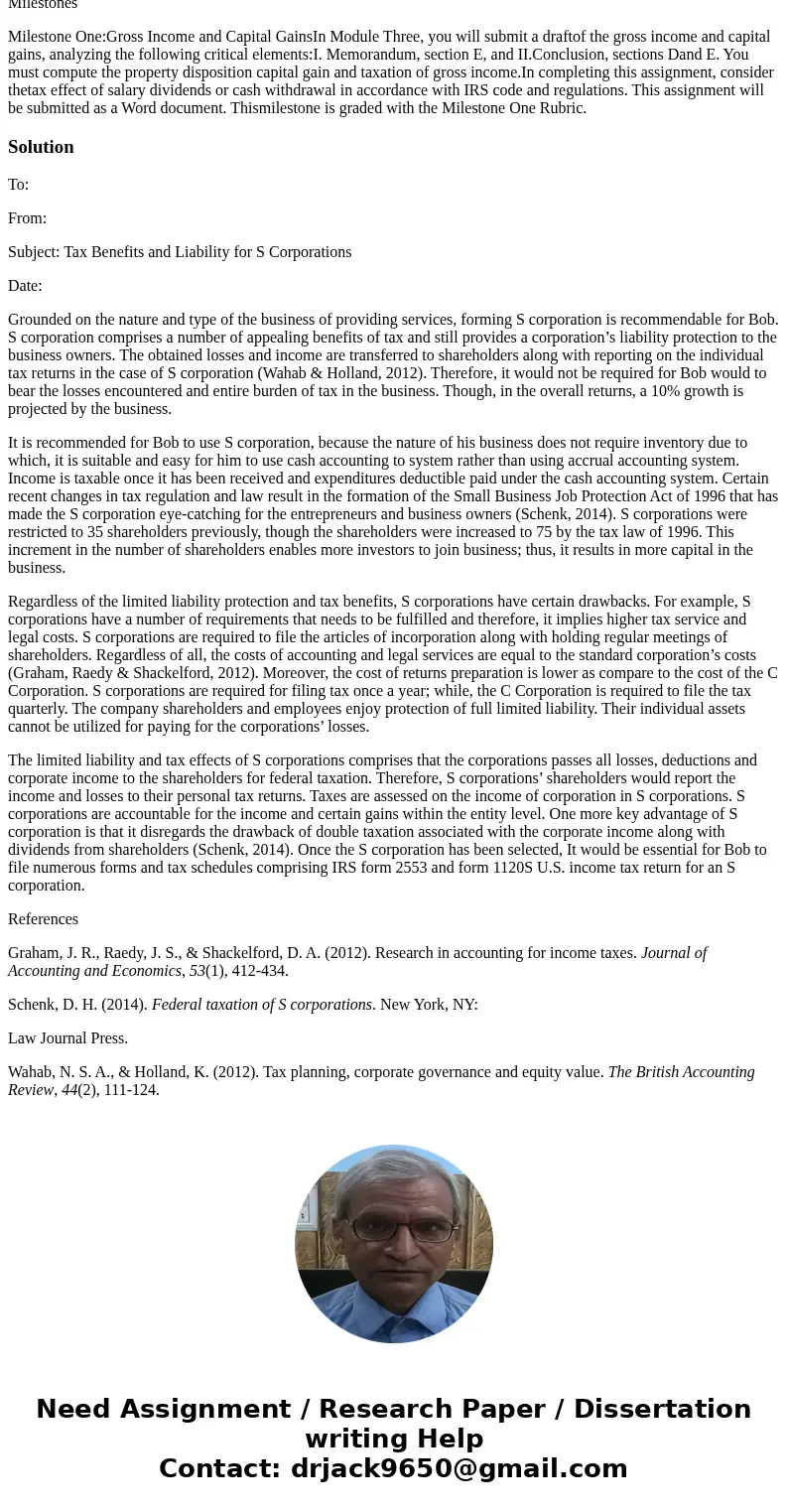You are currently working at a midsized certified public acc
You are currently working at a mid-sized certified public accounting firm. Your client is Bob Jones. Bob, age 60 and single, has recently retired from IBM. He has$690,000 available in his 401(k) fund and he is thinking of using that money to open a used car business that will be located at 210 Ocean View Drive inPensacola, Florida. Bob has estimated that the business might make $300,000 in taxable income.
Bob’s personal wealth including investments in land, stocks, and bonds is about $14,000,000. He reported an interest income of $20,000 and dividend income of$6,000 last year. The $14,000,000 includes land worth $9,000,000 that Bob bought in 1966 for $450,000.Bob has hired your firm for professional advice regarding whether he should operate as a sole proprietor, a partnership, an S corporation, or a C corporation. Heis also considering transferring a possible 40% interest in his new business to his daughter Mandy, age 23 and single.Prepare a memorandum to the client, recommending a type of business entity, including an appendix of supporting IRS tax schedules and forms.
I. MemorandumA. Recommend a type of business entity for the client to consider based on your tax research. Consider justifying your recommendation using thecode and regulations that relate to the business entity.B. Differentiate between accrual accounting and cash basis. Based on the type of business and the client’s accounting system, what is the impactwhen revenue is recognized?C. Based on the decision of accrual vs. cash basis, describe when revenue would be recognized on the sale of inventory, and how the accrualreporting differs from cash basis.D. Determine the economic impacton the client’s financial situation. Based on your decision, determine the potential tax liability, keeping in mindappropriate IRS code and regulations.E. Identify the tax consequences on the sale or exchange of the land consistent with capital gain rules. Consider the selling expense, broker’s fees,closing costs, appraisals, and surveys and the correct schedule form to complete.F. Justify whether or not the client should choose a business entity that has limited liability protection. Be sure to include possible future liabilityissues based on the potential economic impact and appropriate IRS code and regulations.G. Describe the tax effecton the recommended business entity and the impact it will have on the client’s personal tax return. Consider addressinghow the business entity affects the completion of the 1040 tax form.
II. ConclusionA. Evaluate the economic impact on the client’s personal returns based on the recommended entity. Justify why the client would not choose theother business entities by informing the client of the differences.B. Justify your recommendation regarding the client’s daughter having an ownership interest. Provide details supporting the recommendationtaking into consideration the jargon and mechanics of the transaction.C. Summarize, using moral reasoning, cash or accrual basis accounting systems in relation to the selected business entity. Consider how theaccounting system impacts revenue recognition, consistent with IRS code and regulations.D. Describe the after tax effects on the client’s cash flow based on the sale of the land that is needed to provide the funds necessary to start thebusiness. Consider including capital gains tax rules.E. Explain whether or not the client and his child should take a salary or cash distribution according to tax purposes and IRS code and regulations.Consider the type of business and the tax effect whether it is salary, dividends, or cash withdrawal.
III. AppendixBased on your recommendation to the client regarding proprietorship, taxable income, and sale of land, complete the appropriate tax schedules andforms described below.A. Prepare the appropriate page of Form 1040 and include the sale of the client’s land on the appropriate tax schedule and form for therecommended business entity. Be certain to complete each tax schedule and form accurately and completely.B. Prepare the appropriate schedule and tax forms to reflect taxable income based on your calculations and the disposition of asset. Be certain tocomplete each tax schedule and form accurately and completely.C. Illustrate how creative problem solving and versatility of thought impact professional advice that you intended to result in the best economicsolutions for the client. Consider providing real-world examples to support your claims.
Milestones
Milestone One:Gross Income and Capital GainsIn Module Three, you will submit a draftof the gross income and capital gains, analyzing the following critical elements:I. Memorandum, section E, and II.Conclusion, sections Dand E. You must compute the property disposition capital gain and taxation of gross income.In completing this assignment, consider thetax effect of salary dividends or cash withdrawal in accordance with IRS code and regulations. This assignment will be submitted as a Word document. Thismilestone is graded with the Milestone One Rubric.
Solution
To:
From:
Subject: Tax Benefits and Liability for S Corporations
Date:
Grounded on the nature and type of the business of providing services, forming S corporation is recommendable for Bob. S corporation comprises a number of appealing benefits of tax and still provides a corporation’s liability protection to the business owners. The obtained losses and income are transferred to shareholders along with reporting on the individual tax returns in the case of S corporation (Wahab & Holland, 2012). Therefore, it would not be required for Bob would to bear the losses encountered and entire burden of tax in the business. Though, in the overall returns, a 10% growth is projected by the business.
It is recommended for Bob to use S corporation, because the nature of his business does not require inventory due to which, it is suitable and easy for him to use cash accounting to system rather than using accrual accounting system. Income is taxable once it has been received and expenditures deductible paid under the cash accounting system. Certain recent changes in tax regulation and law result in the formation of the Small Business Job Protection Act of 1996 that has made the S corporation eye-catching for the entrepreneurs and business owners (Schenk, 2014). S corporations were restricted to 35 shareholders previously, though the shareholders were increased to 75 by the tax law of 1996. This increment in the number of shareholders enables more investors to join business; thus, it results in more capital in the business.
Regardless of the limited liability protection and tax benefits, S corporations have certain drawbacks. For example, S corporations have a number of requirements that needs to be fulfilled and therefore, it implies higher tax service and legal costs. S corporations are required to file the articles of incorporation along with holding regular meetings of shareholders. Regardless of all, the costs of accounting and legal services are equal to the standard corporation’s costs (Graham, Raedy & Shackelford, 2012). Moreover, the cost of returns preparation is lower as compare to the cost of the C Corporation. S corporations are required for filing tax once a year; while, the C Corporation is required to file the tax quarterly. The company shareholders and employees enjoy protection of full limited liability. Their individual assets cannot be utilized for paying for the corporations’ losses.
The limited liability and tax effects of S corporations comprises that the corporations passes all losses, deductions and corporate income to the shareholders for federal taxation. Therefore, S corporations’ shareholders would report the income and losses to their personal tax returns. Taxes are assessed on the income of corporation in S corporations. S corporations are accountable for the income and certain gains within the entity level. One more key advantage of S corporation is that it disregards the drawback of double taxation associated with the corporate income along with dividends from shareholders (Schenk, 2014). Once the S corporation has been selected, It would be essential for Bob to file numerous forms and tax schedules comprising IRS form 2553 and form 1120S U.S. income tax return for an S corporation.
References
Graham, J. R., Raedy, J. S., & Shackelford, D. A. (2012). Research in accounting for income taxes. Journal of Accounting and Economics, 53(1), 412-434.
Schenk, D. H. (2014). Federal taxation of S corporations. New York, NY:
Law Journal Press.
Wahab, N. S. A., & Holland, K. (2012). Tax planning, corporate governance and equity value. The British Accounting Review, 44(2), 111-124.


 Homework Sourse
Homework Sourse